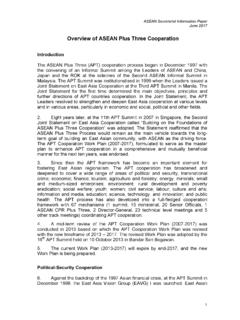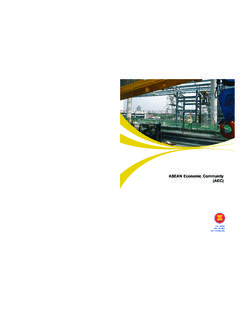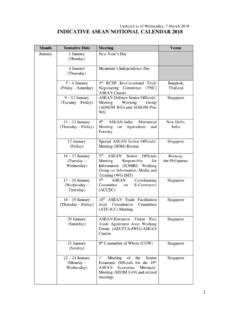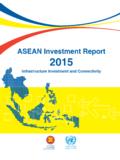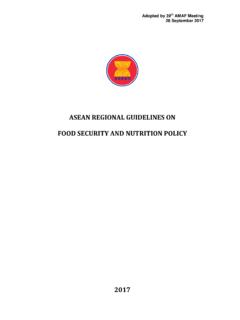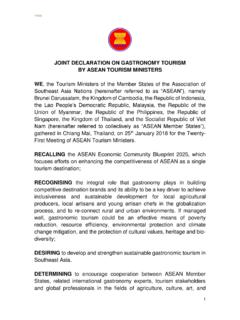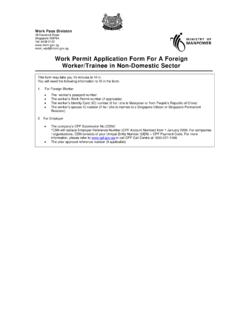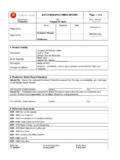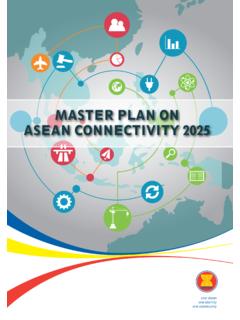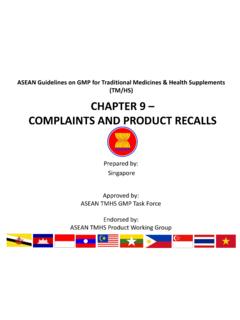Transcription of ASEAN QUALIFICATIONS REFERENCE FRAMEWORK
1 ASEAN QUALIFICATIONS REFERENCE FRAMEWORK Endorsed by the ASEAN Economic Ministers in August 2014; the ASEAN Education Ministers in September 2014; and the ASEAN Labour Ministers through Ad-referendum from November 2014 to May 2015 ACRONYMS AANZFTA ASEAN -Australia-New Zealand Free Trade Area AEC ASEAN Economic Community AECSP AANZFTA Economic Cooperation Support Programme AEM ASEAN Economic Ministers ALMM ASEAN Labour Ministers Meeting AMS ASEAN Member States APEC Asia-Pacific Economic Cooperation APQN Asia-Pacific Quality Network AQAN ASEAN Quality Assurance Network AQRF ASEAN QUALIFICATIONS REFERENCE FRAMEWORK ASEAN Association of Southeast Asian Nations ASED ASEAN Education Ministers Meeting EQF European QUALIFICATIONS FRAMEWORK INQAAHE International Network for Quality Assurance Agencies in Higher Education MRAs Mutual Recognition Arrangements NQF National QUALIFICATIONS FRAMEWORK TVET Technical and Vocational Education and Training 1 The ASEAN QUALIFICATIONS REFERENCE FRAMEWORK 1.
2 Background The ASEAN Charter, which was signed by the ten ASEAN Leaders in Singapore on 20 November 2007, provides the basis for an ASEAN QUALIFICATIONS REFERENCE FRAMEWORK (AQRF). The Charter aims to: create a single market and production base which is stable, prosperous, highly competitive and economically integrated with effective facilitation for trade and investment in which there is free flow of goods, services and investment; facilitated movement of business persons, professionals, talents and labour; and free flow of capital and develop human resources through closer cooperation in education and life-long learning and in science and technology, for the empowerment of the peoples of ASEAN and for the strengthening of the ASEAN Community .1 In 2007, the ASEAN Member States (AMS)2 adopted the ASEAN Economic Community (AEC) Blueprint ( ASEAN 2007).
3 It called for cooperation, including the recognition of professional QUALIFICATIONS . In addition to Mutual Recognition Arrangements (MRAs) in Engineering and Nursing signed in 2005 and 2006 respectively, five MRAs were concluded between 2007 and 2009 in the fields of Architecture, Surveying, Medicine, Dentistry and Accountancy. Another important component of the AEC Blueprint was the creation of the free flow of skilled labour through harmonisation and standardisation ( ASEAN 2007:18), particularly in preparation for the AEC in 2015. ASEAN is also linked to the Asia Pacific region through cross membership of the Asia-Pacific Economic Cooperation (APEC) and the Asia-Pacific Quality Network (APQN). Several AMS who participated in the APEC Mapping of QUALIFICATIONS Frameworks indicated in-principle support for the concept of a regional QUALIFICATIONS FRAMEWORK (Burke, et al, 2009).
4 Regional context ASEAN Member States have a combined population of almost 600 million with considerable differences in population levels, sizes of the economies and development levels based on per capita income. Despite the increasing labour flows between the Member States, the volume has not been as great as in some other regions. Nevertheless, ASEAN , as a robust entity, continues to be active in building mutual economic and social cooperation between and among each Member State. The ASEAN region, typical of other global regions, is characterised by varying development and levels of national QUALIFICATIONS FRAMEWORK (NQF). Some AMS have established comprehensive NQFs, others have sectoral frameworks in place, and others have yet to develop or implement QUALIFICATIONS frameworks. Within this context, the AQRF aims to accommodate different types of NQFs that are at different stages of development, ranging from those that are initial conceptual proposals to those that are fully developed and functioning NQFs.
5 1 Charter of the Association of Southeast Asian Nations (2007), Chapter I, Article 1, paras. 5 and 10. 2 The ASEAN Member States are Brunei Darussalam, Cambodia, Indonesia, Lao PDR, Malaysia, Myanmar, Philippines, Singapore, Thailand, and Vietnam. 2 Chronological development of the AQRF The concept proposal for a region-wide QUALIFICATIONS FRAMEWORK was developed through the Project on Education and Training Governance: Capacity Building for National QUALIFICATIONS Frameworks which is supported under the Agreement Establishing the ASEAN -Australia-New Zealand Free Trade Area (AANZFTA) Economic Cooperation Support Programme (AECSP). Under the program s services component, the concept proposal was first considered at the 1st Meeting of the FTA Joint Committee for AANZFTA in May 2010 in Manila and approved inter-sessionally in July 2010.
6 In an AANZFTA Forum entitled ASEAN Regional QUALIFICATIONS FRAMEWORK held from 29-30 April 2011 in Bangkok, Thailand a draft concept paper (see Bateman et al 2011) for a mutually comparable NQFs based on a common REFERENCE FRAMEWORK was provided to ASEAN participants. In the Forum Communiqu , the participants noted the need for an ASEAN common REFERENCE FRAMEWORK . The feasibility of a regional common REFERENCE FRAMEWORK was discussed in a broad sense, but no consensus was made regarding the preferred construction or features of the regional common REFERENCE FRAMEWORK or what might be the clear purposes for a FRAMEWORK . The concept paper was subsequently enhanced and refined incorporating the outcomes of the deliberations at the AANZFTA Forum and a series of in-country workshops and consultations with relevant stakeholders. In 2012, the FTA Joint Committee agreed to establish and provide technical support to a multi-sectoral Task Force on ASEAN QUALIFICATIONS REFERENCE FRAMEWORK (TF-AQRF), comprising officials from ASEAN ministries of trade in services, labour/manpower development, education, other relevant ministries and QUALIFICATIONS agencies, to develop the AQRF.
7 Representatives of Australia and New Zealand were invited as non-voting members of the task force. From 30 October to 1 November 2012, a workshop and the first TF-AQRF meeting were convened in Bangkok to facilitate discussion of design options within the scope of the draft concept paper for the AQRF. Further refinements to the model were undertaken as a result of the workshop and task force meeting. In March 2013 in Jakarta, Indonesia, another workshop back-to-back with the second meeting of the TF-AQRF discussed the model for an AQRF which would be further refined for purposes of in-country consultations. In November 2013 in Kuala Lumpur, Malaysia, the AMS continued to work together to finalise the key features, underlying principles and structure of the AQRF. At its fourth Meeting in March 2014, in Yangon, Myanmar, the TF-AQRF finalised the text of the FRAMEWORK .
8 The AQRF was then submitted for endorsement by the ASEAN Economic Ministers (AEM), ASEAN Labour Ministers (ALMM) and the ASEAN Education Ministers (ASED) Meetings. 2. Structure Scope The ASEAN QUALIFICATIONS REFERENCE FRAMEWORK , a common REFERENCE FRAMEWORK , functions as a device to enable comparisons of QUALIFICATIONS across AMS. 3 The AQRF addresses education and training sectors3 and the wider objective of promoting lifelong learning. Purpose The purpose of the AQRF is to enable comparisons of QUALIFICATIONS across AMS that will: Support recognition of QUALIFICATIONS Encourage the development of QUALIFICATIONS frameworks that can facilitate lifelong learning Encourage the development of national approaches to validating learning gained outside formal education Promote and encourage education and learner mobility Promote worker mobility Lead to better understanding of QUALIFICATIONS systems Promote higher quality QUALIFICATIONS systems The AQRF will support and enhance each ASEAN Member State s national QUALIFICATIONS FRAMEWORK or QUALIFICATIONS system while providing a mechanism to facilitate comparison, transparency and higher quality QUALIFICATIONS systems.
9 This is achieved through: A process of peer learning across AMS, for example in design and operation of QUALIFICATIONS systems A better understanding of a Member State s national QUALIFICATIONS system, for example by making it clearer to those in other AMS Applying quality processes used in other AMS The AQRF will link the ASEAN NQFs or QUALIFICATIONS systems and become a part of the ASEAN s mechanism for recognition of its QUALIFICATIONS against other regional QUALIFICATIONS systems. Principles The AQRF is based on agreed understandings between AMS and invites voluntary engagement from each Member State. The AQRF by design aims to be a neutral influence on the NQFs of AMS. The aim is to make national QUALIFICATIONS systems explicit according to the AQRF and does not require changes to national QUALIFICATIONS systems. The AQRF respects each Member State s specific structures and processes which are responsive to national priorities.
10 The process for endorsing the AQRF shall be by mutual agreement of the AMS. The AMS will be able to determine when they will undertake the processes of referencing their QUALIFICATIONS FRAMEWORK , system or QUALIFICATIONS types and quality assurance systems against the AQRF. Quality assurance Quality assurance is a component of quality management and is focused on providing confidence that quality requirements will be fulfilled (AS/NZS 2006). In relation to training and educational services, quality assurance refers to planned and systematic processes that provide confidence in educational services provided by training providers under the remit of relevant authorities or 3 Education and training incorporates informal, non-formal and formal learning. Formal learning includes but is not limited to post compulsory schooling, adult and community education, TVET and higher education.
